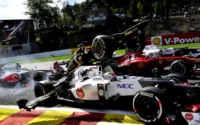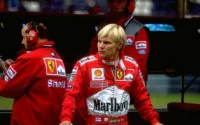Mika Hakkinen is a Finnish former racing driver who competed in Formula One from 1991 to 2001. Known as “The Flying Finn,” Hakkinen secured two Formula One World Championship titles, winning back-to-back championships in 1998 and 1999 with McLaren.
| Nationality | Finnish |
|---|---|
| Born | Mika Pauli Häkkinen 28 September 1968 Vantaa, Uusimaa, Finland |
Hakkinen’s journey to F1 began at the age of five in karting, where he quickly showed promise by winning several regional and national championships. By 1987, he progressed to junior formula racing, where he continued to impress. Under the mentorship of 1982 Formula One World Champion Keke Rosberg, Hakkinen clinched his first title in Nordic Formula Ford and went on to win the 1990 British Formula Three Championship with West Surrey Racing. His success earned him a spot in the Marlboro driver academy, which led to a contract with Lotus in 1991, where he made his Formula One debut at the 1991 United States Grand Prix.
After two challenging seasons with Lotus, Hakkinen joined McLaren in 1993 as a test driver. Later that season, he partnered with Ayrton Senna to replace Michael Andretti for the final three races. Hakkinen quickly made an impact, earning his first podium at the 1993 Japanese Grand Prix.
Over the following seasons, he established himself as a consistent driver despite the unreliable Peugeot engine in the MP4/9, finishing fourth in the 1994 championship with six podium finishes, despite a one-race ban after triggering a multi-car crash at the start of the 1994 German Grand Prix. The incident activated a suspended penalty he’d received just one race earlier for a last-lap collision with Rubens Barrichello at Silverstone. His collision with David Coulthard at Hockenheim led to a massive first-corner pile-up, prompting the FIA to enforce the ban without appeal.
Formula One History Recommends
McLaren’s struggles continued in 1995 and 1996, but Hakkinen secured his first Formula One victory at the 1997 European Grand Prix.
In 1998, Hakkinen endured a season-long title fight with Michael Schumacher. He ultimately secured his first World Championship at the season’s final race, becoming the first Finnish Formula One World Champion in 16 years. He successfully defended his title in 1999, narrowly defeating Eddie Irvine, as Schumacher missed several races due to injury. Although Hakkinen continued to win races in 2000, Schumacher claimed the championship that year. Hakkinen retired from Formula One after the 2001 season, with his final victory at the 2001 United States Grand Prix. Over his career, he achieved 20 race wins, 26 pole positions, 25 fastest laps, and 51 podium finishes.
Following his Formula One career, Häkkinen competed in the Deutsche Tourenwagen Masters (DTM) from 2005 to 2007 with HWA. After retiring from racing in 2007, he shifted focus to driver management and became a brand ambassador for Mercedes-AMG.
Mika Hakkinen Formula One World Championship career
| F1 Career | 1991–2001 |
|---|---|
| Teams | Lotus, McLaren |
| Engines | Judd, Ford, Peugeot, Mercedes |
| Entries | 165 (161 starts) |
| Championships | 2 (1998, 1999) |
| Wins | 20 |
| Podiums | 51 |
| Career points | 420 |
| Pole positions | 26 |
| Fastest laps | 25 |
| First entry | 1991 United States Grand Prix |
| First win | 1997 European Grand Prix |
| Last win | 2001 United States Grand Prix |
| Last entry | 2001 Japanese Grand Prix |
Mika Hakkinen Teammates
| 8 Teammates | Involvement | First Year | Last Year |
|---|---|---|---|
| Julian Bailey | 4 | 1991 | |
| Johnny Herbert | 24 | 1991 | 1992 |
| Michael Bartels | 4 | 1991 | |
| Ayrton Senna | 3 | 1993 | |
| Martin Brundle | 15 | 1994 | |
| Mark Blundell | 14 | 1995 | |
| Nigel Mansell | 2 | 1995 | |
| David Coulthard | 99 | 1996 | 2001 |
Race Wins
| Win Number | Grand Prix |
|---|---|
| 1 | 1997 European Grand Prix |
| 2 | 1998 Australian Grand Prix |
| 3 | 1998 Brazilian Grand Prix |
| 4 | 1998 Spanish Grand Prix |
| 5 | 1998 Monaco Grand Prix |
| 6 | 1998 Austrian Grand Prix |
| 7 | 1998 German Grand Prix |
| 8 | 1998 Luxembourg Grand Prix |
| 9 | 1998 Japanese Grand Prix |
| 10 | 1999 Brazilian Grand Prix |
| 11 | 1999 Spanish Grand Prix |
| 12 | 1999 Canadian Grand Prix |
| 13 | 1999 Hungarian Grand Prix |
| 14 | 1999 Japanese Grand Prix |
| 15 | 2000 European Grand Prix |
| 16 | 2000 Austrian Grand Prix |
| 17 | 2000 Hungarian Grand Prix |
| 18 | 2000 Belgian Grand Prix |
| 19 | 2001 British Grand Prix |
| 20 | 2001 United States Grand Prix |
Complete Formula One results
| Year | Team | Chassis | Engine | 1 | 2 | 3 | 4 | 5 | 6 | 7 | 8 | 9 | 10 | 11 | 12 | 13 | 14 | 15 | 16 | 17 | WDC | Points |
|---|---|---|---|---|---|---|---|---|---|---|---|---|---|---|---|---|---|---|---|---|---|---|
| 1991 | Team Lotus | Lotus 102B | Judd EV 3.5 V8 | USA Ret | BRA 9 | SMR 5 | MON Ret | CAN Ret | MEX 9 | FRA DNQ | GBR 12 | GER Ret | HUN 14 | BEL Ret | ITA 14 | POR 14 | ESP Ret | JPN Ret | AUS 19 | 16th | 2 | |
| 1992 | Team Lotus | Lotus 102D | Ford HB 3.5 V8 | RSA 9 | MEX 6 | BRA 10 | ESP Ret | SMR DNQ | 8th | 11 | ||||||||||||
| Lotus 107 | Ford HB 3.5 V8 | MON Ret | CAN Ret | FRA 4 | GBR 6 | GER Ret | HUN 4 | BEL 6 | ITA Ret | POR 5 | JPN Ret | AUS 7 | ||||||||||
| 1993 | Marlboro McLaren | McLaren MP4/8 | Ford HBE7 3.5 V8 | RSA | BRA | EUR | SMR | ESP | MON | CAN | FRA | GBR | GER | HUN | BEL | ITA | POR Ret | JPN 3 | AUS Ret | 15th | 4 | |
| 1994 | Marlboro McLaren Peugeot | McLaren MP4/9 | Peugeot A6 3.5 V10 | BRA Ret | PAC Ret | SMR 3 | MON Ret | ESP Ret | CAN Ret | FRA Ret | GBR 3 | GER Ret | HUN | BEL 2 | ITA 3 | POR 3 | EUR 3 | JPN 7 | AUS 12 † | 4th | 26 | |
| 1995 | Marlboro McLaren Mercedes | McLaren MP4/10 | Mercedes FO 110 3.0 V10 | BRA 4 | ARG Ret | SMR 5 | ESP Ret | MON Ret | CAN Ret | 7th | 17 | |||||||||||
| McLaren MP4/10B | Mercedes FO 110 3.0 V10 | FRA 7 | GBR Ret | GER Ret | HUN Ret | BEL Ret | ITA 2 | PAC | JPN 2 | AUS DNS | ||||||||||||
| McLaren MP4/10C | Mercedes FO 110 3.0 V10 | POR Ret | EUR 8 | |||||||||||||||||||
| 1996 | Marlboro McLaren Mercedes | McLaren MP4/11 | Mercedes FO 110/3 3.0 V10 | AUS 5 | BRA 4 | ARG Ret | EUR 8 | SMR 8 † | MON 6 † | ESP 5 | CAN 5 | FRA 5 | 5th | 31 | ||||||||
| McLaren MP4/11B | Mercedes FO 110/3 3.0 V10 | GBR 3 | GER Ret | HUN 4 | BEL 3 | ITA 3 | POR Ret | JPN 3 | ||||||||||||||
| 1997 | West McLaren Mercedes | McLaren MP4/12 | Mercedes FO 110E 3.0 V10 | AUS 3 | BRA 4 | ARG 5 | SMR 6 | MON Ret | ESP 7 | CAN Ret | 6th | 27 | ||||||||||
| McLaren MP4/12 | Mercedes FO 110F 3.0 V10 | FRA Ret | GBR Ret | GER 3 | HUN Ret | BEL DSQ | ITA 9 | AUT Ret | LUX Ret | JPN 4 | EUR 1 | |||||||||||
| 1998 | West McLaren Mercedes | McLaren MP4/13 | Mercedes FO 110G 3.0 V10 | AUS 1 | BRA 1 | ARG 2 | SMR Ret | ESP 1 | MON 1 | CAN Ret | FRA 3 | GBR 2 | AUT 1 | GER 1 | HUN 6 | BEL Ret | ITA 4 | LUX 1 | JPN 1 | 1st | 100 | |
| 1999 | West McLaren Mercedes | McLaren MP4/14 | Mercedes FO 110H 3.0 V10 | AUS Ret | BRA 1 | SMR Ret | MON 3 | ESP 1 | CAN 1 | FRA 2 | GBR Ret | AUT 3 | GER Ret | HUN 1 | BEL 2 | ITA Ret | EUR 5 | MAL 3 | JPN 1 | 1st | 76 | |
| 2000 | West McLaren Mercedes | McLaren MP4/15 | Mercedes FO 110J 3.0 V10 | AUS Ret | BRA Ret | SMR 2 | GBR 2 | ESP 1 | EUR 2 | MON 6 | CAN 4 | FRA 2 | AUT 1 | GER 2 | HUN 1 | BEL 1 | ITA 2 | USA Ret | JPN 2 | MAL 4 | 2nd | 89 |
| 2001 | West McLaren Mercedes | McLaren MP4-16 | Mercedes FO 110K 3.0 V10 | AUS Ret | MAL 6 | BRA Ret | SMR 4 | ESP 9 † | AUT Ret | MON Ret | CAN 3 | EUR 6 | FRA DNS | GBR 1 | GER Ret | HUN 5 | BEL 4 | ITA Ret | USA 1 | JPN 4 | 5th | 37 |
Sources:
- Mika Hakkinen. Wikipedia.com




